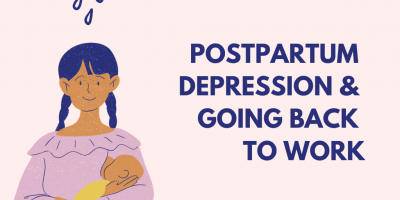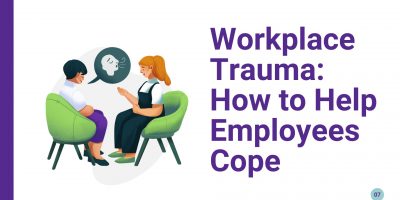
Postpartum Depression & Going Back to Work
Postpartum and peripartum depression (PPD) is the most common mental disorder experienced after childbirth. So, what happens while you’re in the midst of it or recovering, and you’re due to return to work?

Every year, millions of U.S. workers become victims of workplace violence. And although some industries are more prone to it, violence in the workplace can, unfortunately, happen anywhere.
The trauma from such stressful events can significantly affect employees and their mental health, thus disrupting team productivity and morale.
When employers fail to set any proactive protocols in the workplace, they put their staff’s health and well-being at stake.
Therefore, organizations must learn to recognize workplace trauma early on, address it correctly, and support struggling employees throughout their emotional recovery.
Exposure to a traumatic event in the workplace can take its toll on employees. Their immediate and long-term physical or psychological reaction to such events is what experts broadly define as workplace trauma.
Things like work-related accidents, harassment, fear for physical safety, or more extreme threats are just some of the causes of emotional trauma.
Regardless of the reason, these critical incidents prevent workers from reacting and functioning as they normally would, often causing distress, absenteeism, employee conflict, or lack of motivation. Sometimes, the working environment itself works as a trauma trigger, and employees can have a strong reaction even to the thought of entering their workplace.
For employers, a significant concern is how this trauma affects the company culture and the long-term consequences it can have on business growth. When left untreated, trauma symptoms can increase mental health costs within the organization and result in other hidden expenses occurring from low production and excessive sick leave.
Therefore, it’s the responsibility of leadership to react and intervene so that employees can cope and recover from their trauma.

Workplace-induced trauma can result from different environmental, organizational, or individual factors.
Many believe that employees who perform high-risk jobs, like military personnel, police officers, or firefighters, are most prone to suffer psychological trauma in the workplace.
Research shows that public health and public safety workers do, in fact, experience many mental health consequences due to their job. However, according to the National Safety Council, industries like education, service providers, and healthcare are more prone to violence than others.
As for the causes of workplace trauma, there are many instigators, including:
Disregarding possible or ongoing trauma in the workplace can be tragic and costly for the organization. Thus, employers and all levels of management must learn how to identify the warning signs and respond promptly.
Supporting workers who have experienced traumatic incidents can be challenging since some workplace trauma symptoms might be subtle.
For example, denial is one of the coping mechanisms workers use to deal with trauma. Thus, noticing changes and warning signs can be complicated when the victims themselves try to avoid the issue.
Consequently, trauma symptoms fall into two main categories – physical and emotional trauma manifestations.
Apart from these two, some symptoms can manifest as adverse behavioral reactions like excessive drinking and drug use, social isolation, and insomnia.
Finally, any change in the workplace following a traumatic event can be reason enough to keep an eye on employees and how they behave. Sometimes, work-related issues like lack of concentration, absenteeism, emotional response to criticism, or low performance can also indicate trauma.
The leadership should be aware of the employees’ mental well-being and take action to resolve emotional trauma in the workplace.
One way of doing that is to set up a policy on violence that includes employee training, an emergency action plan, and a zero-tolerance approach toward workplace violence.
Employers can’t prevent workplace trauma, but they can take action to ensure employees feel safe, maintain focus and resume production.
As first responders to employee trauma, managers and HR professionals should demonstrate empathy and understanding throughout the healing process.
All people handle traumatic events differently.
So, there isn’t a one-fits-all approach to trauma exposure measures. Instead, managers and HR can offer support using many different methods.
Unresolved trauma can cause post-traumatic stress disorder (PTSD) or a decline in mental health, leading to depression. Therefore, building a company culture that destigmatizes trauma and mental health can create a safe environment for affected employees and help their recovery.
Promoting mental health in the workplace includes employee training and mental health programs. But it also means encouraging open conversations and creating support systems where employees feel comfortable discussing their mental health with their managers, HR, or other colleagues.
Trauma can affect the workplace environment by disrupting productivity. Employees might have trouble focusing on a task, or they’ll need more time to process events and ask for extended sick leave. So, team leaders will have to push back deadlines and rearrange team assignments and schedules.
However, it’s good to first discuss these changes with employees and consult with them to gain insight into what might ease their situation. Some would prefer to work to keep their minds off the traumatic occurrence. Others might need a long break after experiencing workplace trauma.
Employers can also turn to flexible working hours or a hybrid work model if that’s doable. That can be especially helpful when workers lose concentration quickly, or the working environment triggers them to re-experience the trauma.
Quality Employee Assistant Program (EAP) services can help workers cope with emotional trauma.
Managers and HR teams should include EAPs that cover trauma recovery, grief, and loss support in their overall strategy for employee well-being.
Individual and family support services, EAP referrals to crisis services and counselors, pre and post-incident education, and Critical Incident Stress Debriefing can also help workers return to normalcy.
Making reliable, on-call, and educational resources available through a trusted EPA will improve the odds of a complete employee recovery.



A CISD is an intervention method that companies can use as part of their overall recovery plan. It’s a common non-medical practice intended to help responders to a traumatic event, using a specifically structured approach and a small group setting for immediate intervention.
The goal of a CISD is to reduce stress following employee trauma in the workplace, and it can last anywhere between a few hours to several days.
HR managers should book one within the first three days following the traumatic incident for the best results.
Returning to a pre-event state of mental wellness and work productivity after experiencing a traumatic event takes time and patience.
The leadership should make this process more comfortable for employees and initiate a supportive environment with a sense of security and open communication about workplace trauma. Employees can only start their recovery in a positive working environment built on trust and mutual support.
Businesses need to be proactive in their sustainability efforts, which means staying up-to-date on the latest trends and technologies.
Below are some of the key trends in corporate sustainability that businesses should be aware of.
Disclosure: Some of the products featured in this blog post may come from our partners who compensate us. This might influence the selection of products we feature and their placement and presentation on the page. However, it does not impact our evaluations; our opinions are our own. The information provided in this post is for general informational purposes only.
Browse our curated list of vendors to find the best solution for your needs.
Subscribe to our newsletter for the latest trends, expert tips, and workplace insights!

Postpartum and peripartum depression (PPD) is the most common mental disorder experienced after childbirth. So, what happens while you’re in the midst of it or recovering, and you’re due to return to work?

How important is building relationships and social wellbeing to our health? Do social connections translate to a more satisfying and productive work experience?

Is there still a long way to go in fostering a culture of empathy where depression at work and work depression are viewed and treated with the same respect and urgency as any other health issue?

Learn to recognize workplace trauma early on, address it correctly, and support struggling employees throughout their emotional recovery.
Used by most of the top employee benefits consultants in the US, Shortlister is where you can find, research and select HR and benefits vendors for your clients.
Shortlister helps you reach your ideal prospects. Claim your free account to control your message and receive employer, consultant and health plan leads.